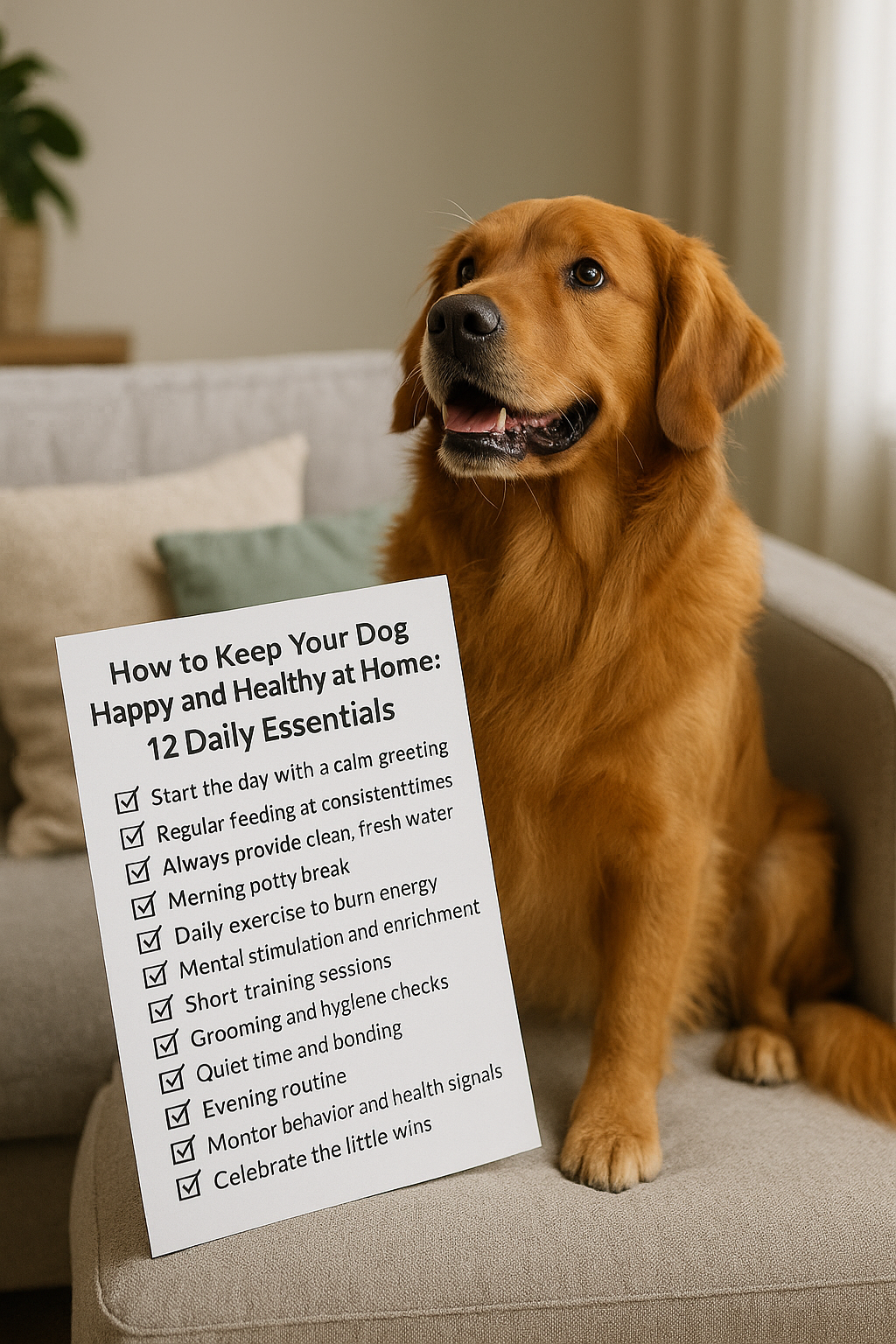Owning a dog means much more than providing food and water. Dogs are social, emotional creatures that thrive on daily interaction, structure, and physical and mental stimulation. If you’re a new dog owner, it can feel overwhelming to figure out what your furry friend needs every day — but it doesn’t have to be complicated.
With a consistent daily routine and a bit of effort, you can ensure your dog is both happy and healthy at home. In this guide, we’ll cover 12 daily essentials that every beginner should follow to create a stress-free and loving home for their canine companion.
1. Start the Day With a Calm Greeting
Mornings set the tone for the entire day — and dogs pick up on your mood and energy immediately.
- Approach your dog with a calm, gentle voice
- Avoid overwhelming them with loud noises or rough play
- Give them a moment to stretch, yawn, and settle before moving into active routines
This builds a calm and respectful environment from the start.
👉 Learn more in Daily Dog Care
2. Regular Feeding at Consistent Times
Structure is comforting for dogs. Feeding your dog at the same times every day helps with digestion, behavior, and routine.
- Puppies: 3–4 meals daily
- Adult dogs: 2 meals daily (morning and evening)
- Senior dogs: Typically 2 smaller meals
Use a measured scoop to ensure proper portion sizes. Keep feeding times within a 30-minute window to maintain consistency.
👉 See feeding guides in Feeding & Nutrition
3. Always Provide Clean, Fresh Water
Hydration supports organ function, digestion, and temperature regulation.
- Clean your dog’s water bowl daily
- Refill with fresh water several times a day
- Add an extra bowl in warm seasons or if your home is large
Some dogs enjoy pet water fountains, which encourage more drinking and reduce standing water.
4. Morning Potty Break
Take your dog out for a bathroom break first thing in the morning. This prevents accidents and sets up a rhythm for the day.
- Use the same exit door and verbal cue (e.g., “Go potty”)
- Reward your dog immediately after they go
- Puppies need to go out more frequently — sometimes every 1–2 hours
Regular breaks are essential for bladder and bowel health.
5. Daily Exercise to Burn Energy
Exercise is a non-negotiable need for every dog, regardless of breed or size.
- Small breeds may do well with short walks and indoor play
- High-energy breeds (like Border Collies, Labs, or Huskies) need structured activity every day
Try these options: morning or evening walks, backyard fetch sessions, tug-of-war indoors, agility exercises or flirt poles
👉 See energy levels by breed in Dog Breeds & Behavior
🔗 External: AKC – Dog Exercise Guide
6. Mental Stimulation and Enrichment
Dogs need to use their minds as much as their muscles.
Try: puzzle toys, training games, scent tracking activities, hide-and-seek with treats
A mentally stimulated dog is less likely to bark excessively, chew furniture, or dig holes.
👉 Start mental games in Dog Training Basics
🔗 ASPCA – Canine Enrichment Tips
7. Short Training Sessions
Training isn’t just for puppies — it’s a lifelong relationship-building activity.
Spend 5–10 minutes a day reinforcing: basic obedience (sit, stay, down, come), leash manners, door boundaries, recall
Use treats, praise, or toys as rewards. Keep sessions short and fun, not stressful.
👉 Explore more in Dog Training Basics
8. Grooming and Hygiene Checks
Grooming should be a regular part of your dog’s day or week, not a rare task.
- Brush daily for long-haired breeds, weekly for short-haired dogs
- Check ears for dirt or odor
- Look at teeth for tartar or bad breath
- Inspect paws and belly for cuts or ticks after walks
Frequent, gentle grooming helps your dog get used to being handled and reduces stress during vet visits.
👉 Tips by breed in Dog Breeds & Behavior
👉 Health basics in Dog Health Tips
9. Quiet Time and Bonding
It’s not all about walks and training — your dog also needs emotional connection.
- Sit with your dog during calm moments
- Gently pet them without any goal
- Let them rest next to you while you read or watch TV
This reinforces your bond and helps reduce separation anxiety.
👉 Balance your home life in Home Life with Dogs
10. Evening Routine
Just like children, dogs benefit from a predictable wind-down routine.
- Light walk or final potty break
- Quiet play or cuddling
- Reduce bright lights and noise
Avoid high-energy activities close to bedtime. Crate-trained dogs often appreciate being gently guided to their space with a treat.
11. Monitor Behavior and Health Signals
Take a few moments each day to observe your dog closely. You might notice things like:
- Lethargy or overexcitement
- Limping or joint stiffness
- Coughing, sneezing, or eye discharge
- Changes in appetite or thirst
The sooner you catch changes, the easier they are to treat. If you notice anything unusual, take note and contact your vet if needed.
👉 Track trends in Dog Health Tips
12. Celebrate the Little Wins
Every day won’t be perfect — but small daily victories matter.
- Celebrate successful potty training
- Recognize good leash behavior
- Praise calm moments indoors
- Track progress and stay patient
You’re not just raising a dog — you’re building a lifelong relationship.
👉 Support your journey with Puppy Essentials
Final Thoughts: It’s the Daily Habits That Matter Most
Keeping your dog happy and healthy doesn’t require special tools or complex routines. It’s about consistency, presence, and respect for your dog’s needs. These 12 daily habits will help you create a calm, connected, and fulfilling life together.
👉 Find more beginner tips in Daily Dog Care
👉 Adjust your space with Home Life with Dogs
